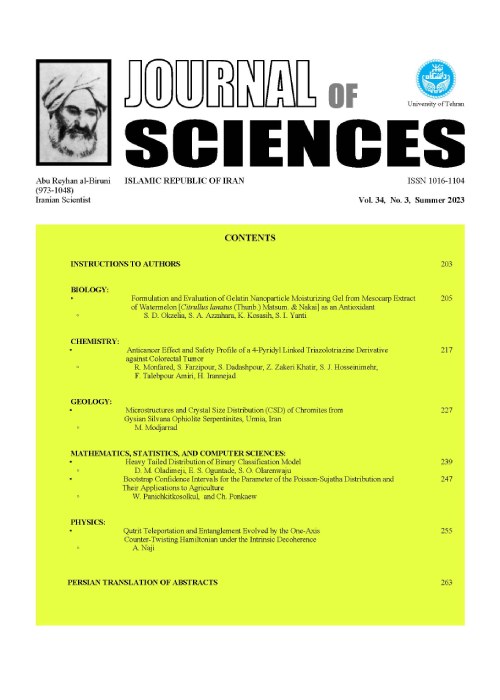فهرست مطالب
Journal of Sciences, Islamic Republic of Iran
Volume:13 Issue: 4, Autumn 2002
- تاریخ انتشار: 1380/10/25
- تعداد عناوین: 7
-
Pages 303-309The patients evaluated in this study were classified into three groups of severe, moderate, and mild according to the severity of exposure to sulfur mustard. We evaluated the Immunological and Cytogenetical status of the patients after eight years of their exposure to sulfur mustard. The investigations revealed that the number of neutrophils, lymphocytes and monocytes in the patients with severe exposure were significantly different than in the normal population, while moderate and mild groups showed no significant differences. We also evaluated the DNA indices (hypo diploid, diploid & hyperploid) in the severe, moderate and mild groups comparing to normal population. The results indicate that in patients with severe exposure 22 out of 26 patients had aneuploidy, while moderate and mild groups showed no significant differences compared to the normal population. Regarding the numerical aberration rate and chromosomal breakage, our results indicated that there were no significant differences among moderate exposure, mild exposure and normal population.Keywords: Chromosome breakage, DNA index, Sulfur mustard
-
Pages 323-3266-Carbethoxy-5-(3''-bromophenyl)-3-aryl-2-cyclohexenones 2a-j were obtained from the1-Aryl-3-(3''-bromophenyl)-2-propene-1-ones 1a-j by Micheal addition of ethyl acetoacetate, followed by internal Claisen condensation. Reaction of 2a-j with hydrazine hydrate afforded the corresponding 6-Aryl-4-(3''-bromophenyl)-3-oxo-2,3a,4,5-tetrahydro-2H-indazoles 3a-j. The structures of newly synthesized compounds were established on the basis of elemental analyses, IR, NMR and Mass spectral data. The pharmacological evaluations were performed for their anticancer, antitubercular and antimicrobial activities.Keywords: Cyclohexenones, Indazoles, Anticancer activity, Antitubercular activity, Antimicrobial activity
-
Pages 327-337The relations of fibrolite-biotite are discussed by presenting data from the Ardara aureole, NW Ireland. Biotite-fibrolite intergrowths are developed in all three aureole zones including: the outer kyanite-bearing andalusite zone, the middle kyanite-free andalusite zone and the inner prismatic sillimanite zone. A strain-assisted mechanism is proposed for the fibrolitisation of biotite in the Ardara aureole. The concentration of fibrolite in zones of high non-coaxial strain, which wrap around zones of low co-axial strain, now occupied by minerals such as plagioclase (in the outer kyanite-bearing andalusite zone), andalusite (in the middle kyanite-free andalusite zone) and pods rich in biotite, quartz and plagioclase (in the inner sillimanite zone) provides strong evidence that fibrolite growth was syn-kinematic. Some textural evidence, especially from the inner sillimanite zone is consistent with continuation of fibrolite growth after ductile deformation.Keywords: Fibrolite, Aureole, Non, coaxial strain
-
Pages 339-356The study of planktonic foraminifera of the Ilam and Gurpi formations at Sarvestan area (SE of Shiraz) enables me to find the most standard biozones defined in mediterranean regions, especially Tethysian domain. Seven biozones were determined. Biozones I (Dicarinella concavata zone) and II (Dicarinella asymetrica zone) belong to the Ilam Formation and indicate the Late Coniacian-Early Santonian and Middle-Late Santonian, respectively. Biozones III to VII were determined from the Gurpi Formation. Biozones III (Globotruncanita elevata zone), IV (Globotruncana ventricosa zone) and V (Globotruncanita calcarata zone) represent the Early, Middle and Late Campanian, respectively. Biozones VI (Globotruncanita stuarti zone) and VII (Gansserina gansseri zone) suggest the Early and Middle Maastrichtian, respectively. In the Late Maastrichtian, due to decreasing in water depth at the study area, Abathomphalus mayaroensis zone defined in Tethysian domain, was not recognised.Keywords: Ilam Formation, Gurpi Formation, Upper Cretaceous, Planktonic Foraminifera, Biozonation
-
Pages 357-362Let R be a ring and V be a matrix valuation on R. It is shown that, there exists a correspondence between matrix valuations on R and some special subsets Σ(MVPR) of the set of all square matrices over R, analogous to the correspondence between invariant valuation rings and abelian valuation functions on a division ring. Furthermore, based on Malcolmson’s localization, an alternative proof for the following result is presented. “There exists a natural bijection between the matrix valuations on R and valuated epic R-fields.”Keywords: Matrix valuation, Epic field, Localization, Valuation ring
-
Pages 363-365Let X be a hypergroup. In this paper, we study the homomorphisms on certain subspaces of L(X)* which are weak*-weak* continuous.Keywords: Homomorphisms, Hypergroup algebras, Weak*, weak* continuous
-
Pages 367-372In this paper, we investigate the concept of topological stationary for locally compact semigroups. In [4], T. Mitchell proved that a semigroup S is right stationary if and only if m(S) has a left Invariant mean. In this case, the set of values μ(f) where μ runs over all left invariant means on m(S) coincides with the set of constants in the weak* closed convex hull of right translates of f. The main purpose of this paper is to prove a topological analogue (which is also a generalization) of this theorem for locally compact semigroups.Keywords: Topological stationary, Topological left invariant mean


